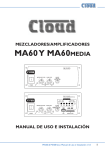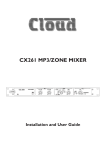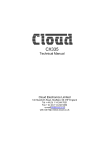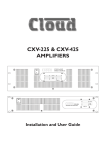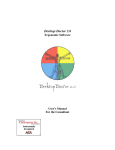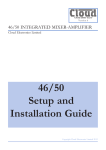Download Cloud CXM User guide
Transcript
CXM Mixer Installation & User Guide Cloud Electronics Limited 140 Staniforth Road, Sheffield, S9 3HF England Tel +44 (0)114 244 7051 Fax +44 (0)114 242 5462 e-mail [email protected] web site http://www.cloud.co.uk CXM Technical MANUAL 1 CXM MODULAR MIXER Technical manual Contents Section Page 1 General ........................................................................................................ 3 1.01 1.02 1.03 General Description ........................................................................................ 3 Main Frame ..................................................................................................... 3 Power Supply ............................................................................................... 3-4 2 CS1 Stereo Music Module ................................................................... 5 2.01 2.02 2.03 2.04 2.05 2.06 2.07 2.08 2.09 2.10 2.11 2.12 2.13 2.14 2.15 2.16 CS1 Stereo Music Module .............................................................................. 5 Input Amplifier Equalisation............................................................................. 5 Input Specification ........................................................................................... 5 Input Gain........................................................................................................ 5 Input Select ..................................................................................................... 5 Sub-Sonic Filter............................................................................................... 5 Equalisation..................................................................................................... 5 Stereo / Mono.................................................................................................. 6 Crossfade Assignment .................................................................................... 6 Auxiliary sends ................................................................................................ 6 Balance ........................................................................................................... 6 PFL (Pre Fade Listen)..................................................................................... 6 Peak LED ........................................................................................................ 6 Channel Fader ................................................................................................ 6 Remote Start Switch ....................................................................................... 6 PCB Jumpers .................................................................................................. 7 3 CM1 Microphone Module ..................................................................... 8 Facilities .......................................................................................................... 8 Input Specification ........................................................................................... 8 Input Select ..................................................................................................... 8 Input Gain........................................................................................................ 8 Phantom Powering .......................................................................................... 8 Equalisation..................................................................................................... 8 100Hz High Pass Filter ................................................................................... 8 Equalisation..................................................................................................... 9 Auxiliary Sends................................................................................................ 9 Pan Control ..................................................................................................... 9 PFL (Pre Fade Listen) ..................................................................................... 9 Peak LED ........................................................................................................ 9 Channel Fader................................................................................................. 9 Channel Mute Switch ...................................................................................... 9 Channel Insert ................................................................................................. 9 PCB Jumpers ................................................................................................ 10 3.01 3.02 3.03 3.04 3.05 3.06 3.07 3.08 3.09 3.10 3.11 3.12 3.13 3.14 3.15 3.16 CXM Technical MANUAL 4 2 4.01 4.02 4.03 4.04 4.05 4.06 4.07 4.08 4.09 4.10 4.11 4.12 4.13 4.14 4.15 4.16 4.17 4.18 M2 Master Module................................................................................. 11 X-Filter........................................................................................................... 12 Crossfade ...................................................................................................... 12 Chopfade....................................................................................................... 12 Signal Routing ............................................................................................... 12 Music Only Output......................................................................................... 12 Microphone Only Output ............................................................................... 12 Main Output.............................................................................................. 12-13 Output 2......................................................................................................... 13 AVO ............................................................................................................... 13 Master Auxiliary Sends ................................................................................. 13 Auxiliary Return ............................................................................................. 13 PFL / Headphone Amplifier ........................................................................... 13 Split Cue........................................................................................................ 13 PFL Output .................................................................................................... 14 Remote Music Mute ...................................................................................... 14 Emergency Signal Input ................................................................................ 14 Mono/Sub-Bass Output................................................................................. 14 Sound to Light Output ................................................................................... 15 5 CZ1 Zone Module .................................................................................. 17 5.01 5.02 5.03 5.04 5.05 Facilities ........................................................................................................ 17 Zone 1 ........................................................................................................... 17 Zone 2 ........................................................................................................... 17 Zone 3 ........................................................................................................... 17 Retro-fitting the CZ1 ...................................................................................... 17 6 General ...................................................................................................... 19 6.01 6.02 6.03 Recording from the CXM............................................................................... 19 Unbalanced Mode ......................................................................................... 19 Earthing ......................................................................................................... 19 7 Service and Configuration ................................................................ 20 7.01 7.02 Module Removal ........................................................................................... 20 Crossfade Replacement................................................................................ 20 Diagrams 1.20 1.03 2.16 3.16 4.17 4.00 4.28 Panel Template and Cut-Out .......................................................................... 3 Power Supply Installation................................................................................ 4 CS1 Stereo Music Module Jumpers ............................................................... 7 CM1 Microphone Module Jumpers............................................................... 10 M2 Jumper settings....................................................................................... 15 M2 Rear Panel Connections ......................................................................... 16 CZ1 Zone Module ......................................................................................... 18 WARNING This technical manual is intended as information and assistance for the technically qualified audio installation engineer. Some of the data herein could be mis-interpreted by the end user with serious or even disastrous consequences. For these reasons, this manual should not be left with the CXM mixer after installation, unless the end user can prove his or her electronic qualification. A 'User's Guide' is provided for operator instruction. Cloud Electronics Ltd, Sheffield, England CXM Technical MANUAL 1 1.01 3 General Description The Cloud CXM mixer is primarily designed for 'live' discotheque use, yet it is equipped with such flexible facilities that it may successfully be used in a wide range of applications such as broadcast and production studios. The console has advanced specifications and rugged construction. Its compact dimensions make effective use of limited space such as in DJ booths and small studios. 1.02 The main frame, complete with master module, is available in three sizes, with space for 8, 12, or 16 channel modules. Two different types of input channel modules are available, one being specifically designed for music programme, the other with features to suit a microphone input. A stylish angle mounting kit is supplied with the main frame. If desired this can be discarded to allow flat panel mounting. The 8 module main frame can be 19" rack mounted and occupies 9U of rack space. See figure 1 for template and cut-out details. 117mm OVERALL WIDTH: 8 MODULE - 520mm 12 MODULE - 677mm 16 MODULE - 834mm 20.00mm NOTE THE ANGLED MOUNTING KIT CAN BE SCREWED TO THE MOUNTING SURFACE PANEL CUT-OUT WIDTH - 8 MODULE MIXER - 444.00mm 473mm PANEL CUT-OUT WIDTH - 12 MODULE MIXER - 601.00mm PANEL CUT-OUT WIDTH - 16 MODULE MIXER - 758.00mm PANEL CUT-OUT DEPTH (ALL 3 TYPES) 410.00mm 43.00mm NOTE: CLEARANCE OF 150mm BELOW THE MOUNTING LEVEL SHOULD BE ALLOWED FOR ACCESS TO REAR PANEL CONNECTIONS 1.03 The PSU 1040 power supply is designed to be surface mounted remotely from the mixer. The main ± 17.5V DC power rails have a slow rise characteristic to reduce switch on thumps. In addition, a separate ± 15V DC provides power for headphone amplifiers and display drivers. Microphone phantom power is provided and can be configured to operate from + 17.5V DC or + 48V DC. A mains input in the range 220 to 240 volts at 40 - 60 Hz is required and a moulded mains lead is supplied with the unit. When a fused plug is fitted, this should have a rating of 1A. CXM Technical MANUAL 4 The PSU 1040 can be modified to operate from a supply of 110 - 120V by removing the internal link marked '240V' and fitting two adjacent links marked '110 - 120V'. The 220 240V fuse rating of T500mA should be changed to T1A for 110 - 120V operation. Adequate ventilation must be provided to ensure safe and reliable operation of this power supply. Remember that the PSU 1040 has a captive output lead, which is 900mm long, this factor must be considered when positioning the PSU. The mains earth connection to the PSU should be of the highest specification, not only for audio quality but for the operator safety aspect, as many of the connected input sources often rely on the audio mixer for their ground connections, e.g. turntables, microphones, etc. CXM Technical MANUAL 5 CS1 Stereo Music Module 2.01 This module contains RIAA equalised phono and line level amplifiers, sub-sonic filter, equaliser, auxiliary sends, channel fader, crossfade assign, mono switch, PFL select logic and remote start switch. Inputs are by way of gold plated RCA phono sockets. 2.02 Input Amplifier Equalisation Two input amplifiers are fitted. The RIAA equalised phono input has an input impedance of 47kΩ, loaded with a capacitance of 220pF. The RIAA equalisation is accurate to within ± 0.5dB 30Hz-20kHz. This input amplifier can be configured internally with a 3 position jumper. The 3 input options are: INPUT OPTION RIAA Flat response @ 0dBu Flat response @ -10dBu DESCRIPTION For moving magnet cartridges. For CD players and other ancillaries with outputs compatible with an input range of-12dBu to +12dBu For low output ancillaries requiring an input range of -22dBu to +2dBu. If this option is selected, consider the possible risk of overload with incorrect gain settings. 2.03 Input Specification The line amplifier is unbalanced with an input impedance of 47kΩ and a nominal input sensitivity of 0dBu. 2.04 Input Gain The gain range for both input amplifiers is trimmed to ±12dB with reference to the centre (unity gain) point of the gain control. 2.05 Input Select The input select switch is positioned at the top of the module with LED status indication. A provision to mark the fascia with input source details is adjacent. 2.06 Sub-Sonic Filter A permanent sub-sonic filter attenuates signals below 20Hz at a rate of 18dB/oct. This filter is positioned pre-equalisation thus preventing sub-sonic signals being boosted by the bass control. 2.07 Equalisation The equaliser has 3 bands, each band having a defined range resulting in a controlled response outside the audio spectrum. In addition, the range of boost and cut can be internally configured to operate at ± 12dB or limited to ± 6dB by simply reversing a single circuit jumper. A second jumper can be used to bypass the equalisation (see drawing). The HF control operates at 10kHz, mid at 1200Hz and LF at 50Hz, all 3 controls have a centre detent for positive neutral setting. Factory default settings are ± 6dB with equalisation in circuit. CXM Technical MANUAL 6 2.08 Stereo/mono A mono switch is included and this simply links the two stereo signals, the adjacent LED illuminates when the signals are linked. 2.09 Crossfade Assignment Two crossfade assign switches are provided; with both switch A and switch B in the off position, stereo signals are routed to bypass the crossfade circuitry. Switch A routes signals to channel A and similarly switch B to channel B; adjacent LED's indicate the selected channel. The switches are arranged to give priority to channel A necessitating the release of channel A prior to selecting channel B. (See 4.01 and 4.02 for details of crossfade and chopfade on master module). 2.10 Auxiliary Sends Two auxiliary sends are provided and can be individually configured to operate in the pre-fade or post-fade mode by simply reversing a single circuit jumper (see detail). This facility can be used to interface a variety of units for signal processing, sampling, digital effects or as a flexible extra output facility. Factory settings configure Aux 1 pre-fade and Aux 2 post-fade. 2.11 Balance Control The balance control operates at -3dB at centre to infinity at extremes, with a centre detent to aid positive positioning. 2.12 PFL (Pre Fade Listen) This logic controlled momentary action switch routes the pre-fade signals to the headphone amplifier and lower stereo LED bargraph display. The selection of a channel PFL automatically cancels any prior selection. The adjacent LED indicates status. 2.13 Peak LED A red LED indicates the peak signal level at the pre-fade point and illuminates at a level of approximately 4dB below clipping. 2.14 Channel Fader The channel fader has a slide length of 100mm and an exceptionally smooth feel. Under normal operating conditions, the fader is used fully open or fully off. 2.15 Remote start switch A low voltage, fully floating, momentary action switch is fitted as standard. The contact rating is 30V at 0.1A and is terminated with a 2 pole 3.5mm jack socket. A latching action switch is available as an option. CXM Technical MANUAL 7 2.16 PCB Jumpers The locations of the PCB configuration jumpers can be seen on the diagram to the left. The list below explains each jumper, its approximate position and default settings. J1 Left Phono Input Select, located on overhead PCB, factory set to RIAA equalisation. 3 possible settings, RIAA, 0dBu or -10dBu. Unpredictable input gain and EQ will be evident if this jumper header is missing. J2 Right Phono Input Select, located on overhead PCB, factory set to RIAA equalisation. 3 possible settings, RIAA, 0dBu or -10dBu. Unpredictable input gain and EQ will be evident if this jumper header is missing. Should always match J1 setting. J3 EQ Defeat for Left and Right channels, located behind LF potentiometers, factory set to equalisation in circuit. 2 possible settings, in or out. If this jumper header is missing the EQ will always be out of circuit. J4 EQ Range for Left and Right channels, located behind Mono push switch, factory set to ±6dB. 2 possible settings, ±6dB or ±12dB. If this jumper header is missing then EQ range will always be set to ±12dB. J5 Auxiliary Send 1 Pre / Post Fade, located behind the Aux 1 potentiometer, factory set to Pre Fade. 2 possible settings, Pre or Post Fade level. If this jumper header is missing then Aux Send 1 will not operate. J6 Auxiliary Send 2 Pre / Post Fade, located behind the Aux 2 potentiometer, factory set to Pre Fade. 2 possible settings, Pre or Post Fade level. If this jumper header is missing then Aux Send 2 will not operate. CXM Technical MANUAL 8 CM1 Microphone module 3.01 The CM1 module contains a low noise balanced microphone amplifier with line level switching, a 100Hz high pass filter, 3 band equalisation, line level insert, 2 auxiliary sends, Pan control, PFL select, Peak LED, channel fader and mute switch. 3.02 The microphone amplifier is an electronically balanced, transformerless design, configured for optimum low noise performance. The input impedance is greater than 2kΩ and suitable for microphones in the 200 - 600 Ohm range. A gold plated 3 pin XLR type connector with latch is located on the rear of the module. To run the XLR input in an un-balanced mode it is suggested that the pin 3 terminal be shorted to the ground terminal (pin 1) inside the cable plug. The high level line input is electronically balanced with an input impedance greater than 20kΩ. A 3 pole 1\4" jack socket on the rear panel is used for the balanced line input. If it is desirable to use the line input in an unbalanced mode, a 2 pole 1/4" jack plug can be used. 3.03 Input select switch This 2 position switch selects either the microphone input or the line input and has adjacent LED's indicating the selected input. 3.04 Input Gain Trim The microphone input can be varied between 16dB and 54dB of gain. The line level input has a gain range from -4dB to 34dB. 3.05 Phantom Power Capacitor microphones can be powered by the 48 volt or 17.5 volt power supply. A circuit jumper on the module PCB is used to turn the power on and off. Phantom power must not be used on unbalanced inputs and it is good practice to disable phantom power when using conventional dynamic microphones as a potential lead fault could load the supply line. The PSU 1040 is factory set for 48V operation and all CM1 modules leave the factory with phantom power disabled. 3.06 Equalisation HF (High Frequency) This control provides 15dB of boost or cut with a 'shelving' response. A switch adjacent to the HF control selects the turn over frequency of either 5KHz or 10KHz. MID (Middle Frequencies) This control is continuously variable between 300Hz and 5KHz, with 15dB of boost or cut at the selected frequency. LF (Low Frequency) A range of 15dB of boost and cut at 50Hz is provided with a similar 'shelving' characteristic to that of the HF control. 3.07 100Hz High Pass Filter A 12dB/octave filter operating at 100Hz. This can be effective in removing low frequency system rumble, handling noise and other extraneous signals, resulting in a cleaner vocal response particularly when bass boost is used. A yellow LED illuminates when the filter is effective. CXM Technical MANUAL 9 3.08 The equaliser circuitry can be switched in or out of the signal path by simply configuring a PCB jumper. This operates independently of the 100Hz high pass filter. 3.09 Auxiliary Sends 2 auxiliary sends are provided and can be individually configured to operate in the pre-fade or post-fade mode by simply reversing a PCB jumper (see detail). This facility can be used to interface a variety of units for signal processing, sampling digital effects or a flexible extra output facility. Factory settings configure Aux 1 to be pre-fade and Aux 2 as post-fade. 3.10 Pan Control This control operates at -3dB at centre, to infinity at the control extremes, with a centre detent to aid positive central image setting. The pan pot is used to place the mono signal anywhere within the stereo image. 3.11 PFL (Pre fade listen) This logic controlled momentary action switch, routes the pre-fade signal to the headphone amplifier and PFL stereo LED bar graph display. The selection of a channel PFL automatically cancels any prior selection and the adjacent LED indicates status. 3.12 Peak LED A red LED indicates the peak signal level at the pre-fade point and illuminates at a level of approximately 4dB below clipping. 3.13 Channel Fader The channel fader has a slide length of 100mm and an exceptionally smooth feel. Under normal operating conditions, the fader is used fully open in conjunction with the mute switch. 3.14 Mute Switch This momentary action logic controlled switch operates silently and consistently and can be used to conveniently turn the mic channel on and off. The logic control can be configured with a PCB jumper to operate the booth output mute function on the M3 Master Module, or the 'AutoMute' Facility on the CZ1. This mute function operates post insert and mutes all effect sends and PFL. The jumper is factory set to the 'off' position. 3.15 Insert A 3 pole 1/4" jack socket is provided on the rear panel. This insert point operates at a level of 0dBu and is situated post EQ, pre-fade. A variety of signal processing units can be used for single channel effects such as compression etc. This can also be used as a direct microphone signal output. CXM Technical MANUAL 10 3.16 PCB Jumpers The locations of the PCB configuration jumpers can be seen on the diagram to the left. The list below explains each jumper, its approximate position and default settings. Equalisation jumper, located next to the insert jack socket, factory set in the active position. 2 possible settings; EQ active or defeated. No output will be possible from this channel if this jumper header is missing. Auxiliary Send 1 Pre / Post Fade, located behind the Aux 1 potentiometer, factory set to Pre Fade. 2 possible settings, Pre or Post Fade level. Aux Send 1 will not function if this jumper header is missing. Auxiliary Send 2 Pre / Post Fade, located behind the Aux 2 potentiometer, factory set to Post Fade. 2 possible settings, Pre or Post Fade level. Aux Send 2 will not function if this jumper header is missing. Phantom Power jumper, located above the 34 way buss connector, factory set to the Off position. If this jumper header is missing then +48 Volts phantom power will be Off. Booth Mute/AutoMute jumper, located to the side of the 34 way buss connector, factory set to the Off position. If this jumper header is missing then Booth Mute will never function on this channel. CXM Technical MANUAL M2 Master Module 11 CXM Technical MANUAL 12 4.01 X-Filter When used in conjunction with the crossfade the X-Filter facility on the M2 allows the user to mix selected bands of frequencies from one crossfade busbar together with selected frequencies from the other busbar. The three X-Filter buttons on the left-hand side can be used to remove any combination of top, mid and low frequencies from the signal on the A busbar. The three buttons on the right provide the same function for the B busbar. Illumination of the led adjacent to the switch indicates that the band of frequencies has been ‘cut’. 4.02 Crossfade The A & B music busbars are routed through the X-Filter to the crossfade control circuitry. This smooth acting 45mm fader can then be used to fade from the A busbar to the B busbar at the extremity of travel; a centre detent is fitted to allow positive positioning. In the central position, both A & B busbar signals are operational with no signal loss. 4.03 Chopfade This function uses logic controlled momentary action switches to 'chop' from A busbar signals to B busbar signals, producing an effect similar to rapidly moving the crossfade from one extremity to the other. This swift switching is totally silent and a useful tool for the inventive DJ. The central momentary switch turns the effect on and off, with random selection. For a positive condition upon switch on, the A or B switch should be depressed at the time of switching on. Holding both A & B switches will result in both channels operating, simulating the centre fader position. Note that the X-Filter effects the signals going to the chopfade as well as the signal going to the crossfade. 4.04 M2 Master Module signal routing The main stereo music busbar is summed with the crossfade output; this combined signal is then routed to the master music fader and subsequently the music only output. The microphone busbar is also summed and routed to the master microphone fader and microphone only output. These two signals are then combined to form the main output signal. The pre-fade music and mic signals are also sent to the Output 2 level controls, then summed to provide a secondary output. The provision of separate mic and music outputs allows the use of the rack mounting CX Zoner, providing a high degree of flexibility particularly when the mixer and zoner are part of a complex discotheque sound system. This extends the zone capabilities of the mixer from the standard two output zones (main output and output 2), giving an additional five zones. This facility for configuring mic/music levels in up to seven zones and the capability of reducing the mic level in the booth to reduce feedback are useful facilities. 4.05 Music Only Output The music only output is fully balanced and uses separate 3 pin XLR type connectors for left and right outputs which can be used in the unbalanced mode if required, with a 6dB loss in gain (See 6.02 "Unbalanced Mode"). The rated output of OdBu (775mV) should interface with most equipment but is primarily intended to connect to the Cloud CX Zoner. 4.06 Microphone Only Output This microphone only output is controlled by the master microphone fader and uses separate 3 pin XLR type connectors for the left and right balanced outputs which can be used in unbalanced mode if required, with a 6dB loss in gain (see 6.02 "Unbalanced Mode"). The rated output of OdBu (775mV) should interface with most equipment but is primarily intended to connect to the Cloud CX Zoner. 4.07 Main Output The main output section has separate faders to control the microphone and music signals. The "output" LED display constantly monitors the level and is accurately calibrated if precise control is required. Separate left and right balanced outputs are provided, using 3 pin XLR type connectors which can be used in the unbalanced mode if CXM Technical MANUAL 13 required, with a 6dB loss in gain (see 6.02 Unbalanced Mode). The CXM M2 is designed to interface with equipment requiring OdBu (775mV) signal level and has both gain and headroom margins to successfully match a wide range of ancillary equipment. 4.08 Output 2 The output 2 section is primarily intended to provide an extra output zone, as such it is very similar to the main output. Level control of the mic and music signals is achieved by means of two independent rotary controls. The main output faders have no control over the levels on output 2. As with the main output, separate left and right balanced outputs are provided, using 3 pin XLR type connectors which can be used in the unbalanced mode if required, with a 6dB loss in gain (see 6.02 Unbalanced mode). Output 2 can be configured to provide a mono output by means of a latching push switch which is accessible through a 3mm diameter hole in the rear panel, adjacent to the Output 2 XLRs. 4.09 AVO (Auto Voice Over) Comprehensive auto voice over is provided and features separate controls for Attenuation, Release and Sensitivity. The On/Off switch has LED indication and a further LED illuminates when the operation threshold has been reached. The auto voice over detects any microphone signal to effect gain reduction on music signals. 4.10 Master Auxiliary Sends These Master controls adjust the overall output signal derived from the channel modules. With the control in the maximum position a maximum output of 0dBu (775mV) is available. The balanced stereo output is by way of 1/4" 3 pole jack sockets with a facility for a mono signal by using the left output socket only. For unbalanced operation a 2 pole jack plug should be used. 4.11 Auxiliary Return This stereo input facility is primarily intended to be used for Auxiliary return purposes. The 2 x 1/4" 3 pole jack sockets are used for the balanced inputs and have a sensitivity of 7dBu (350mV) at 20kΩ. The signals are routed to the master music summing amplifier and are subject to attenuation through the AVO circuit. If more comprehensive control of the return signal is required, the use of a channel module is customary. There is also no reason why the Aux return cannot be used as an extra basic input if required. Unbalanced signals can be connected by simply using a 2 pole jack plug. 4.12 PFL / Headphone Amplifier All PFL selections are routed to the stereo headphone amplifier and PFL VU display. The stereo headphone amplifier is extremely powerful, it can deliver over 1 watt per channel into the optimum load of 32 ohms. If high listening levels are a pre-requisite, we recommend the use of headphones with an impedance in the range 8 to 60 ohms. Performance into 600Ω 'phones is more than adequate and a 3 pole 3" jack socket is provided on both the front and rear panels. The installer must be aware of health and safety requirements of IEC TC84 regarding sound pressure level when using headphones. The use of a 2 pole jack plug should be avoided. The input signal follows the selected PFL channel. 4.13 Split Cue It is sometimes required, usually when mixing in sync', to monitor a pre-fade signal with that of the output signal. This is accomplished in the 'split' mode by routing the 2 signals to each half of the stereo headphone amp and PFL display. In this mode, a mono mix of the PFL signal is routed to the left channel with a mono mix of the Main output signal routed to the right channel. A rotary balance control is provided to compensate for different signal levels: this control is operational in the split cue mode only. CXM Technical MANUAL 14 4.14 PFL Output A -2dBu PFL output is provided on a stereo pair of phono sockets. This signal is derived from the PFL and split cue circuits. The output is identical to the signal on the headphone output though it is not affected by the phones volume control. 4.15 Remote Music Mute In certain circumstances, there may be a local authority or Fire Service requirement to mute the Music Signals via a Fire alarm control panel in an alarm condition. The CXM M2 provides a facility to mute the music signals. The option to mute mic signals in addition to the music signals is set by means of J2 (see diagram). The mute is activated by a fully floating pair of contacts in the Fire alarm control panel which close during an alarm condition. Do not connect any external voltage sources either AC or DC to the remote music mute connector. Should the alarm panel not have suitable set of contacts then it is usual to use an auxiliary relay. Do not attempt to modify the fire alarm circuits unless you are both qualified and authorised to do so. To indicate that the remote music mute is active, the red LED on the front panel will flash and any current PFL selection will be cancelled, effectively muting the headphone amplifier. Note. It is normal for the music mute to operate for a few seconds when the mixer is switched on. 4.16 Emergency signal input This facility is provided so that pre recorded evacuation message systems can be interfaced to the M2, allowing messages to be broadcast over the main sound reenforcement system. It should be noted that it is unlikely that the main sound reenforcement system will meet the regulations necessary for such an application and therefore this facility should only be used to augment an existing, adequate broadcast system. The emergency signal input is a 3 pin XLR, with an adjacent gain control to accommodate signal levels between +/- 12dBu. The input impedance is 10kOhms. The signal is directly routed to the output stages of the main output, the music output and output 2 with an nominal output level of 0dBu. This facility is NOT present on any other M2 outputs including the outputs of the zone module CZ1. The signal level is not affected by any of the front panel controls. In order to prevent unwanted noise from the equipment connected to this input reaching the outputs under normal operating conditions the signal can be gated by the remote music mute. This facility can be selected by means of a jumper J1. The default position for this jumper is ON. When this facility is enabled the emergency signal is only routed to the outputs when the remote mute is activated. As the emergency signal is routed to the main outputs it is strongly recommended that this ‘gated mode’ is used, particularly if the signal source is either low level, noisy, unbalanced or of questionable integrity. Using this input without the gate is highly likely to raise the noise levels on the outputs. 4.17 Mono/Sub-bass output This balanced output facility uses a 3 pole 1/4" jack socket and can be configured on the PCB to operate as a mono full range main output (see diagram) or as a mono sub-bass output to drive amplifiers with sub-bass enclosures to enhance the lowest frequencies within the audio spectrum. The output level is 0dBu and the low pass filter operates below 63Hz. A 2 pole jack plug can be used for unbalanced signals. The factory default setting is the mono full range output. CXM Technical MANUAL 4.18 15 Sound to Light Output This fully floating, transformer coupled output facility can be used to trigger sound to light controllers. The signal is derived from the main output and is rated at +10dBu (2.45V) with a minimum load of 600Ω. Connection is by way of a 2 pole 1/4" jack socket. CXM Technical MANUAL 16 M2 Master Module Rear Panel Connections CXM Technical MANUAL 17 CZ1 Zone Module 5.01 The CZ1 Module extends the output facilities of the M1 or M2 Master module by providing an extra 3 output zones with independent control of microphone and music levels. 5.02 Zone 1 Two faders are provided to independently control the output level of the microphone and music signals. An internal jumper can be configured to derive the signals either pre master fader or post master fader and a second jumper is used to set the output to operate in mono or stereo. Two 3 pin XLR type connectors are used for the balanced output, rated at OdBu (775mV). The output can be monitored by selecting the respective PFL select button. 5.03 Zone 2 This operates identically to Zone 1 with addition of auxiliary outputs on a pair of RCA type phono connectors. 5.04 Zone 3 Again, 2 faders are provided with signals derived post master fader. The automute facility can be used to mute the output of Zone 3 when any microphone mute switch is in the "on" position. To enable the "automute" facility, one or more of the CM1 microphone input modules must be configured to trigger the mute circuit (see 3.16) and the automute switch should be in the on position. Zone 3 can also be configured to operate in mono or stereo and provides balanced outputs via 3 pin XLR type connectors with auxiliary outputs via RCA type phono sockets. 5.05 Fitting the CZ1 to the mixer main frame The CZ1 zone module connects to the 34 way ribbon cable assembly in much the same way as other modules. However the CZ1 must be connected to the master module by an additional 16 way ribbon cable assembly and to facilitate this the CZ1, must be positioned immediately to the left of the master module. Proceed as follows:Remove the master module and detach the 34 way ribbon cable. Fit the 16 way ribbon cable to the socket on the M1 PCB and route the cable by the side of the crossfade control on the edge of the PCB. Connect the other end of the 16 way cable to the CZ1 module and install the 2 units together into the main frame. Make sure that the 34 way main ribbon cable is firmly connected to the CZ1 and master module(2 sockets) CXM Technical MANUAL CZ1 Zone Module 18 CXM Technical MANUAL 19 General 6.01 Interfacing a tape deck for recording purposes. The M2 master module is fitted with a total of two stereo pairs of record output sockets, all using RCA type phono sockets. One pair carry the main output signal: this output is controlled by the master faders and the system must be operated normally with master faders open sufficiently to give a satisfactory recording level. The other pair of record outputs carry music only, pre-master fader signals. These outputs are not controlled by the master faders and may be used where no mic signals are required to be recorded. The M2 modules have additional XLR outputs carrying music only, pre-master fader signals. These outputs are not controlled by the master faders and may be used where no mic signals are required. If Output 2 is not being used for an additional output zone then it’s balanced, pre-master fade signal offers flexibility as the music and mic signal levels are independently adjustable by means of the rotary front panel controls. If a CZ1 zone module is fitted to the CXM mixer, it is possible to use the auxiliary outputs on Zone 2 or Zone 3 for recording purposes. Possibly the best option would be to use Zone 2 in the pre-fade mode. The mic and music faders would then control the recording level independently of the master faders. Finally, if you are really stuck, the aux send facility could be used (in the post-fade mode) but to keep noise levels to a minimum, only open the channels you intend to use. 6.02 Unbalanced Mode If it is required to have stereo unbalanced outputs from either the Main or Zone groups, as opposed to the normal balanced mode, pin 2 should be used for an in phase signal and pin 1 as ground, note this will give a 6dB reduction in output level. Pin 3 may be used as an output if an anti-phase signal is required instead. Do not connect either output pin to ground. If any input XLR connector is also unbalanced, the same phase should be used as hot. 6.03 Earthing The 0V rail on the CXM mixer is connected to the mains earth via the power supply lead and the mixer power supply must always be earthed. A green earth terminal is provided on the master rear panel to earth turntables, etc. If any mains powered input apparatus has it’s own earth connection to a different point mains point, then earth loop hums might be caused. This 'hum' can be remedied in several ways. One method is to operate all possible circuitry in the balanced mode and connect the signal cable screen at the receiving end only. Alternatively, try to re-route the mains supply of the apparatus to the same point that the CXM power supply is connected to. CXM Technical MANUAL 20 Service and Configuration Access to the inside of the CXM mixer will not normally be required. If any servicing should become necessary or the factory jumpers need re-configuring, then this should only be carried out by qualified service personnel. 7.01 Module removal It may be necessary to remove certain modules to configure the circuitry or routine maintenance etc. All modules can be removed from the front, proceed as follows:1. 2. 3. Remove all the connections to the rear of the module Remove the 2 black M4 screws located at the top and bottom of the module Carefully lift out the module until the 34 way busbar connector is accessible. Move the 2 retaining clips away from the ribbon cable, this action will automatically eject the connector. The module can then be removed from the main frame. If you wish to remove the master module, the adjacent channel module must be removed at the same time. Similarly if the module adjacent to the master module requires removal, access to the busbar connector is more easily afforded if the 2nd module is removed first. To refit the modules, simply proceed in reverse order: it pays to check the alignment of the M4 nuts in the top and bottom extrusions before re-fitting. Note: The master module must be positioned on the right side of the main frame; the busbar harness is not reversible. If all the modules are to be removed, this can be more easily accomplished by removing the steel busbar cover, this is positioned centrally on the rear of the mixer and is fixed by 4 x M4 screws. This will allow complete removal of the ribbon busbar harness. Be sure to refit the shake proof washer to positively ground the cover. 7.02 Crossfade replacement Replacement crossfade modules are available should it need replacing, for example if it is dirty or worn. The crossfade unit can be replaced as follows: 1. Remove the 2 outermost screws either side of the fader. 2. Lift out the fader carefully, ensuring that the cables to the fader do not get damaged. 3. Unplug the fader cable from the fader PCB. 4. Reverse the procedure to fit the new fader module. CXM Technical MANUAL 21 This product conforms to the following European Standards: EN 50081-1:1992 EN 50082-1:1992 EN 60065:1994 Safety Considerations THIS UNIT MUST BE EARTHED. ENSURE THAT THE MAINS POWER SUPPLY PROVIDES AN EFFECTIVE EARTH CONNECTION USING A THREE WIRE TERMINATION. Caution - Mains Fuse TO REDUCE THE RISK OF FIRE, REPLACE THE MAINS FUSE ONLY WITH THE SAME TYPE AND RATING, WHICH MUST BE A CLASS 3, 250V TIME DELAY TYPE, RATED AT 500mA WHERE THE MAINS INPUT VOLTAGE IS SET TO 230V.± ± 10% AC FOR A MAINS INPUT VOLTAGE OF 115V ±10% AC, THE FUSE SHOULD BE RATED AT 1A. THE FUSE BODY SIZE IS 20mm x 5mm. CAUTION - SERVICING THIS UNIT CONTAINS NO USER SERVICABLE PARTS. REFER SERVICING TO QUALIFIED SERVICE PERSONNEL. DO NOT PERFORM SERVICING UNLESS YOU ARE QUALIFIED TO DO SO. WARNING TO REDUCE THE RISK OF FIRE OR ELECTRIC SHOCK, DO NOT EXPOSE THIS UNIT TO RAIN OR MOISTURE. 25/01/01






















